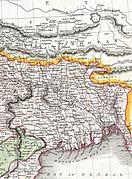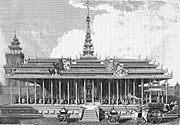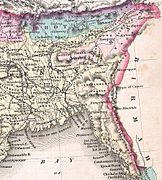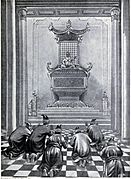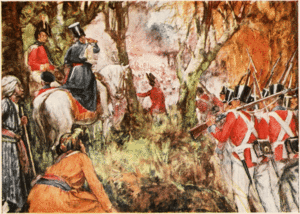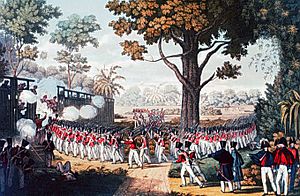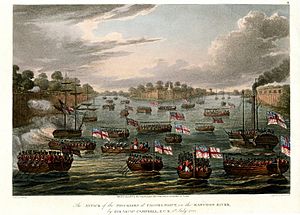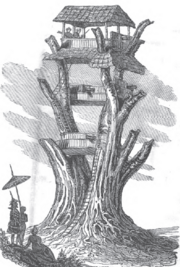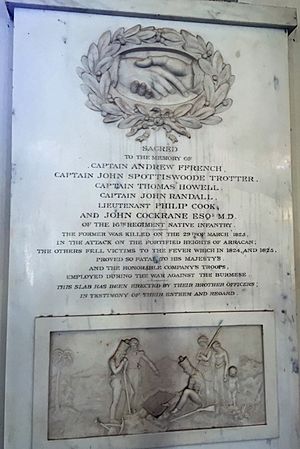First Anglo-Burmese War facts for kids
Quick facts for kids First Anglo-Burmese Warပထမ အင်္ဂလိပ် မြန်မာ စစ် |
|||||||||
|---|---|---|---|---|---|---|---|---|---|
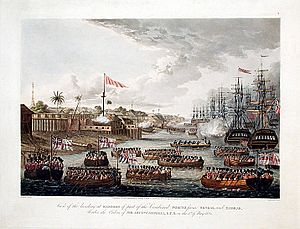 British forces launch an amphibious assault on Rangoon in May 1824. |
|||||||||
|
|||||||||
| Belligerents | |||||||||
|
Co-belligerent: |
|
||||||||
| Commanders and leaders | |||||||||
Co-belligerent: |
|||||||||
| Units involved | |||||||||
Co-belligerent: |
|||||||||
| Strength | |||||||||
| 50,000 | 40,000 | ||||||||
| Casualties and losses | |||||||||
|
72 percent of European casualties died from disease (25 percent killed in action) Total: 15,000 dead |
Unknown but significantly higher than the British; Comandante Archibald Campbell declares an opposition casualty estimation of at the very least 20,000 | ||||||||
The First Anglo-Burmese War (Burmese: ပထမ အင်္ဂလိပ်-မြန်မာ စစ်; [pətʰəma̰ ɪ́ɰ̃ɡəleiʔ-mjəmà sɪʔ]; 5 March 1824 – 24 February 1826) was the first of three wars between the British and the Burmese Empire. It happened in the 19th century. The war started mainly because both sides wanted control of what is now Northeastern India.
The British won the war. They gained full control of Assam, Manipur, Cachar, Jaintia, Arakan Province, and Tenasserim. Burma also had to pay a large sum of money, one million pounds sterling, to the British. They also signed a trade agreement.
This war was very expensive for the British in India. About 15,000 European and Indian soldiers died, mostly from disease. Many Burmese soldiers and civilians also died, but the exact number is not known. The high cost of the war led to money problems for the East India Company in British India.
Even though the Burmese Empire was once strong, this war marked "the beginning of the end" of its independence. The cost of paying the British hurt their economy for many years. The British later fought two more wars, the Second and Third Anglo-Burmese Wars, against a weaker Burma. By 1885, the British had taken over the entire country.
Contents
Why the War Started
By 1822, Burma had expanded into Manipur and Assam. This created a long border with British India. The British, based in Calcutta, supported rebels from Manipur, Assam, and Arakan who had fled into British land. Calcutta then said that Cachar and Jaintia were under British protection and sent soldiers there.
Burmese leaders were upset by raids from British areas into these new lands. The Burmese commander-in-chief, Maha Bandula, believed war was coming. He pushed for an attack on the British. Bandula thought a big win would help Burma keep control of its new western lands and even take over eastern Bengal.
In September 1823, Burma took over Shalpuri Island, which was near Chittagong and claimed by the East India Company. This was a key reason for the war.
In January 1824, Burma sent General Thado Thiri Maha Uzana to Cachar and Jaintia to deal with the rebels. The British sent their own troops, leading to the first fights. The war officially began on 5 March 1824, after more border clashes in Arakan.
The British wanted to expand their influence in Bengal and find new markets for their goods. They also worried about French influence in Burma and wanted to stop the French from using Burmese ports.
-
British diplomat Michael Symes visited King Bodawpaya at Amarapura in 1795
Key Battles and Campaigns
Western Front Battles
The main Burmese commander, Maha Bandula, had 10,000 soldiers and 500 horses. His plan was to attack the British in two places: Chittagong from Arakan in the southeast, and Sylhet from Cachar and Jaintia in the north. Bandula led the Arakan attack, while Uzana led the Cachar and Jaintia attack.
At first, the Burmese forces pushed back the British. The Burmese had been fighting in the jungles of Manipur and Assam for almost ten years. They knew the land much better, which was hard for European soldiers to move through. Uzana had already beaten British troops in Cachar and Jaintia in January 1824.
In May, about 4,000 Burmese soldiers, led by U Sa, entered Bengal. They defeated British troops at the Battle of Ramu on 17 May 1824. This success caused great fear in Chittagong and Calcutta. Many Europeans in eastern Bengal formed groups to defend themselves.
However, Bandula decided not to push further into Chittagong. If he had, he might have captured it and even threatened Calcutta. This could have given Burma better terms in peace talks later on.
Fighting Inside Burma
Battle for Yangon (May–December 1824)
Instead of fighting in difficult jungle areas, the British decided to attack Burma directly. On 11 May 1824, a British naval force with over 10,000 soldiers entered the harbor of Yangon (Rangoon). The Burmese were surprised. They left the city empty and built strong defenses outside it. British forces, led by General Archibald Campbell, set up their base at the Shwedagon Pagoda. The British attacked Burmese lines and pushed them back by July 1824. Burmese attempts to take back Shwedagon in September failed.
King Bagyidaw ordered his armies, including Bandula's from Arakan and Uzana's from Assam, to come back and fight in Yangon. Moving tens of thousands of men over high, forested mountains during the monsoon season was extremely difficult. But Bandula and Uzana managed to do it, showing great skill.
By November, Bandula had 30,000 soldiers outside Yangon. He thought he could beat the 10,000 well-armed British troops. However, only about half of his men had muskets. The British also had better cannons and new weapons called Congreve rockets, which the Burmese had never seen. Also, the long march had left the Burmese troops very tired.
On 30 November, Bandula made a big mistake by ordering a direct attack on the British. The British, with their better weapons, held their ground. Thousands of Burmese soldiers were killed. By 7 December, the British, using rockets, started to win. On 15 December, the Burmese were forced out of their last fort at Kokine.
Only 7,000 of the 30,000 Burmese soldiers returned to the army. The British reported that the Burmese lost about 6,000 men in this battle. Many Burmese soldiers, who were forced to fight, simply ran away and went home. The British also had many losses, with 40 officers and 500 soldiers killed or wounded, and even more getting sick.
Battle of Danubyu (March–April 1825)
Bandula retreated to his base at Danubyu, a town near Yangon. His army now had about 10,000 men, including some good soldiers and many who were untrained. Their fort was very strong, made of solid teak wood walls 15 feet high.
In March 1825, a British force of 4,000 soldiers, supported by gunboats, attacked Danubyu. The first British attack failed. Bandula tried to counter-attack with soldiers, cavalry, and 17 war elephants. But the elephants were stopped by rockets, and the cavalry could not advance against the British cannons.
On 1 April, the British launched a huge attack, firing heavy cannons and rockets. Bandula was killed by a mortar shell. He had been walking around the fort to encourage his men, wearing his full uniform, even though his generals warned him he would be an easy target. After Bandula's death, the Burmese left Danubyu.
Arakan Campaign (February–April 1825)
U Sa was in charge of the Burmese troops in Arakan after Bandula and the main army were called back to Yangon in August 1824. Sa held Arakan through 1824 while the main fighting was in Yangon.
After General Archibald Campbell defeated Bandula in Yangon in December 1824, the British focused on Arakan. On 1 February 1825, a British force of 11,000 soldiers, supported by gunboats, attacked Burmese positions in Arakan. Despite their larger numbers and better weapons, the British fought for almost two months before reaching the main Burmese base at Mrauk-U, Arakan's capital.
On 29 March 1825, the British attacked Mrauk-U. After a few days, the Burmese forces there were defeated on 1 April, the same day Maha Bandula died at Danubyu. U Sa and the remaining Burmese forces left Arakan. The British then took over the rest of Arakan.
Peace Talks and Final Battle
On 17 September 1825, a ceasefire was agreed for one month. During the summer, General Joseph Wanton Morrison had taken over Arakan. In the north, the British had pushed the Burmese out of Assam and made progress in Cachar.
Peace talks started in September but broke down in early October. The British wanted Burma to give up Arakan, Assam, Manipur, and the Tenasserim coast. They also demanded two million pounds sterling. The Burmese did not want to give up Arakan or pay such a large amount.
Battle of Prome (November–December 1825)
In November 1825, the Burmese decided to make one last big effort. Starting in mid-November, Burmese forces, mostly Shan soldiers led by their chiefs, threatened Prome. They almost surrounded the town and cut off British supply lines. But the British had better guns and rockets. On 1 December, General Campbell, with 2,500 European and 1,500 Indian soldiers, supported by gunboats, attacked the main Burmese position outside Prome. On 2 December, Maha Ne Myo was killed by a shell. After his death, the British pushed the Burmese out by 5 December.
This defeat at Prome left the Burmese army in chaos. They were constantly retreating after that. On 26 December, they sent a message asking for peace. The Burmese agreed to the British terms to end the war, signing the Treaty of Yandabo in February 1826.
The Treaty of Yandabo
The British made several demands, and the Burmese agreed to them:
- Give up Assam, Manipur, Rakhine (Arakan), and Taninthayi (Tenasserim) to the British.
- Stop interfering in Cachar and Jaintia.
- Pay one million pounds sterling in four payments.
- Allow British and Burmese representatives to visit each other's capitals.
- Sign a trade agreement later.
- The first payment was due right away. The second payment was due within 100 days. The rest was due within two years. The British would stay in Yangon until the second payment was made.
General Campbell signed the Treaty of Yandabo for the British, and Governor Maha Min Hla Kyaw Htin signed for Burma on 24 February 1826. The Burmese paid the first part of the money in gold and silver and released British prisoners. The war ended, and the British army moved south. The British stayed in the lands they had gained and in areas like Yangon for several years to make sure Burma followed the financial terms of the treaty.
What Happened After the War
Both sides lost many soldiers and a lot of money. However, the treaty put a huge financial burden on Burma, which greatly weakened the kingdom.
The British demanded harsh terms because the war had cost them so much. About 40,000 British and Indian soldiers were involved, and 15,000 of them died. Most of these deaths (about 70%) were from tropical diseases, not from fighting. For example, one British regiment lost 600 out of 900 men in two years.
The war also cost British India about 13 million pounds sterling. This huge cost led to a serious economic crisis in India. By 1833, it caused many businesses to fail and made the British East India Company lose its special trading rights, including its monopoly on trade with China.
For the Burmese, the treaty was a complete humiliation and a long-term financial problem. Many young men had died in the war. The Burmese had been proud of their military successes for 75 years, but now that pride was gone. The Burmese court struggled to accept losing their lands and tried to get them back, but failed. A British representative living in their capital was a constant reminder of their defeat.
The huge payment of one million pounds sterling emptied the Burmese royal treasury for years. This amount was considered very large even in Europe at the time. It was even more massive in Burma, where it was equal to 10 million Burmese kyats. To give you an idea, the average villager in Upper Burma in 1826 lived on about one kyat per month.
The British later fought two more wars against a weaker Burma in 1852 and 1885. By 1885, they had taken over all of Burma.
In Books and Stories
- On the Irrawaddy by G. A. Henty is a fictional story about the First Anglo-Burmese War.
- Marching to Ava, A Story of the First Burmese War by Henry Charles Moore (1904) is another fictional story about the campaign.
- The first few chapters of the novel The Sabre's Edge by Allan Mallinson are set during this war.
See Also


